It's Wednesday, my guest blogger's day to take over. Enjoy it!
Just before I start I did say I would report back on my query to the Allerdale Borough Council in last week’s blog (Allerdale Goat’s Cheese ). If you remember I had found a rather elementary error on their website which mixed up left & right in their description. Being a bit of a cynic I didn’t expect a reply. However within a few working days the actual Mayor of Allerdale’s secretary emailed me with an acknowledgement that their website did need amending as they had got the left/right bits wrong. Well top marks to Allerdale; serves me right for doubting them.
Ok so this week it was a visit to rather odd “attraction” in Liverpool. On my way to the place I passed a few interesting streets. There was one group of consecutive Groves called Fern, Moss, Lime, Cedar & Aspen making you think of being out in countryside instead of traversing a somewhat dreary urban landscape. Then came another (rather cultural) group consisting of Vandyke, Wordsworth, Boswell (curiously no Johnson nearby) & Longfellow Streets. Interestingly at the bottom of Longfellow Street are adjacent pairs of streets named Greenleaf & Whittier (presumably a nod to the poet John Greenleaf Whittier, 1807-92) and Wendell & Holmes (presumably in recognition of Oliver Wendell Holmes, 1841-1935).
Whilst looking for the place, I actually drove past the entrance nestling as it now does between two brand new blocks of housing and set back from the road – 0/10 for me for observation there then but a good excuse.
Here’s the entrance area.
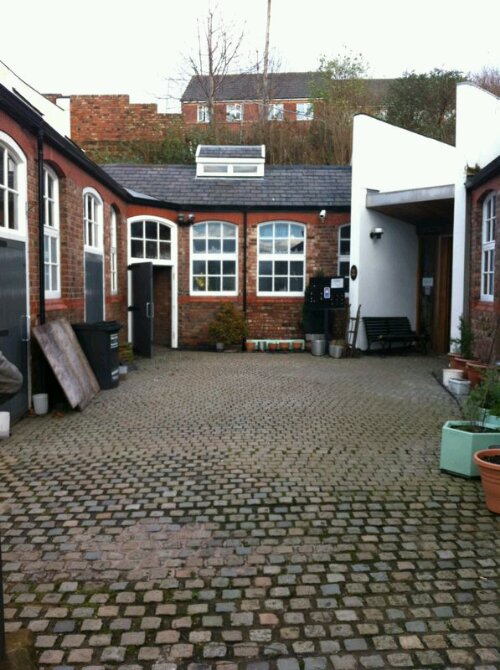
Anyway having rung ahead to book a tour (which the day I went wasn’t actually necessary) I was keen to get going. The lady at the entrance told me the next tour was in 20 mins and perhaps I’d like to go and look at the exhibition area. It provided a fascinating read on a number of story boards, and was not just somewhere to park visitors while they waited for the tour guide. Here there were a couple of men dressed in clothes of the 19th century. I could see clearly that the man kneeling, although appearing ready to pounce, presented no danger - in fact he was completely armless (haha). Yes, if you look closely, you can see that those white sleeves are actually empty!
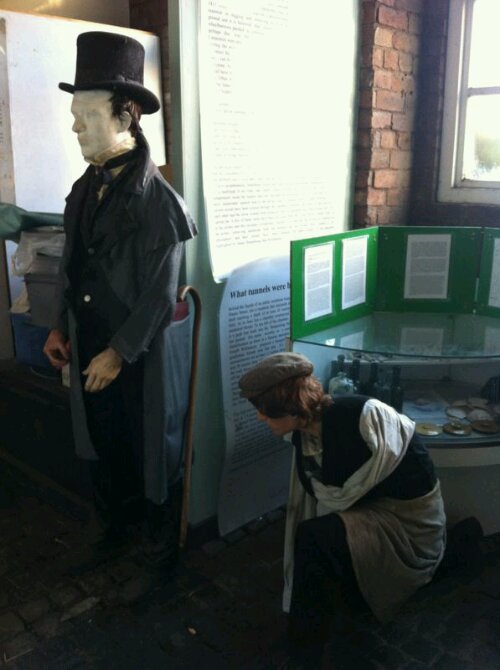
Where was I? Well, it’s a place which had been used by Liverpool Corporation, from 1868 up until the early 1960s, as stabling for some of their horses. The horses were employed to perform tasks in the city before motorised transport became fully established. (In 1935 there were still 5,000 heavy horses working across the city but by the mid-1940s motor transport had begun to take over much of their work.) The various types of horse, going from the smaller ponies right up to the largest shire horses delivered mail, transported people & heavy goods and pulled the bin (refuse) carts round the streets to take away domestic waste. One of the boards told me that when Roy Rogers visited the city his horse Trigger had been stabled at this site. Outside the building I’d probably walked over the same cobbles where Trigger had once stood! It was an emotional moment. However the site’s use as stabling was a far later incarnation; the original was as the site of a strange enterprise employing hundreds of men. Today it is a visitor centre, opened in 2002, called The Williamson Tunnels Heritage Centreand the site is run by The Joseph Williamson Society, a registered charity. It celebrates (and partly showcases) the work of a successful businessman who seemed to really enjoy giving people work but with an odd twist. I’d just about got round all the story boards on the walls in the exhibition area when I was called through for the tour to start. Our guide was Carl and as I looked round for my fellow visitors it seemed there were….. none – ok amend “our” guide to “MY” guide; I hadn’t expected a tour for one but that’s what I got. First things first though, I had to get fitted with the obligatory (green) plastic safety hat. In the unlikely event of tons of rock falling down from overhead I would be ok. Phew that was re-assuring. We (me & the guide that is) went through the doors into the first part of the tunnel experience. I was informed about the man responsible for what I was looking at, well as much as they know so far. Williamson was born in 1769 over in Yorkshire and at some point the family moved to Warrington. Then when he was 11/12 yrs old (about 1780) he came to Liverpool to find work. He found it, and lodgings, with a certain Mr. Richard Tate, a successful tobacco & snuff merchant, who had offices & a factory in the city centre.
Williamson was clearly a man of determined nature and good business acumen because in just over 20 years he had progressed up the company ladder and then actually married the then boss’s sister (who was the daughter of the original boss) in 1802. Richard Tate had died about 15 years earlier leaving the business to his son, Thomas Moss Tate. The following year (1803) he bought out the Tate business and with his other interests made quite a fortune. Three years after that he used some of his money to buy an estate, previously owned by a timber merchant, in the Edge Hill area of Liverpool. Edge Hill back then wasn’t part of Liverpool.
This map of Liverpool is from 1768:
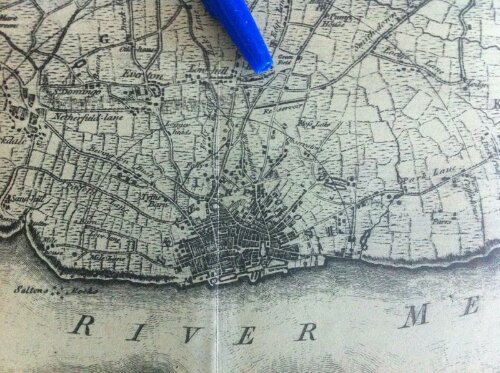
I’ve put the pen on pointing to Smithdown Lane where Williamson’s yard was. You can see there were a few fields and lanes leading down to the heavily populated city area in the centre at the bottom of the map. Early in the 19th century one writer (Charles Hand) described the Edge Hill area rather healthily as having, “fresh air and bracing breezes”. Today of course all that empty space has been built on and extends miles beyond Edge Hill.
He moved into the house a timber merchant had used as his rural retreat and started building houses in the same street. Clearly he wasn’t someone who just wanted kind of manor house away from the city standing on its own. The ground underneath this area was sandstone so the houses all had very solid foundations. However they were situated at the top of quite a steep slope. Because of that slope and in order to be able include a garden for each house Williamson had to build supports on which to make them. The supports took the form of arches onto which the land behind the houses could then be extended. Various sorts of people rented these properties from Williamson. In the 1830s residents occupations included: merchant, chemist, junior attorney, salt merchant, corn merchant, book printer, schoolmaster & gentlewoman. It is the innards of Williamson’s yard, in the next street down from where his own house was, where I’m standing with my guide who’s giving me the talk. Photos inside the tunnel were difficult because it was quite dark but I got a few which we’ll come to. Also the tunnel walk areas were kitted out with Christmas paraphernalia for kids who’ll be visiting over the coming weeks. Now, I have to say at this point, if it’s glitz and high-tech you want as your “visitor experience” this is not the place to come. However if you don’t mind a damp atmosphere and a few drips from the ceiling landing on your shoulders accompanied by a fascinating tale of 18th/19th century eccentricity & philanthropy then this is definitely the place to come. The story is absorbing simply because it’s not about a guy who wanted his name on a stone plaque or on a statue in the city centre. He didn’t make a showpiece for the world to see; he built tunnels underground that few would ever see. And that is what intrigues you as you walk through a small section of his hidden domain.
His yard employed hundreds of local people doing something necessary – building houses and then arches for the gardens; but then something rather bizarre – building tunnels that apparently didn’t lead anywhere. Some just went to a dead end rock face; some went on a circular route bringing you back to your start point. So the question you’re probably asking, like me, is why? At this point it seems to be all conjecture because Williamson apparently left no reason, either written or oral. Most info comes from two men who wrote about him after his death. What you do have are some of the known facts: he was a real person as records exist – he died in 1840 and his grave was found in an old churchyard when digging work on the Liverpool One development was taking place; he employed many people who were able to support their families because of the work he gave them; and that the tunnels were built because we can still see a part of them. The speculation, which appeals to other known info about his character, suggest he was simply a philanthropist who didn’t believe in just giving people money in their hand but was quite happy to reward them for work done. If there was no particular work for their skills then he would make work that they could do and then pay them for it. He employed bricklayers, carpenters, stone masons and labourers. If a worker was good there are stories of Williamson then employing his wife and even children.
It is amazing to look up at the arched ceiling with its neat rows of bricks and to think of all the men working down there, by candlelight, doing the building of it. He was known as “The King of Edge Hill” by his workers and “The Mayor of Edge Hill” by his friends but as “The Mole of Edge Hill” by his detractors. The large scale map the guide showed me marked with all the areas he tunnelled into is very impressive although unfortunately most will never be excavated because they now run under modern developments and are under council owned land.
Anyway here’s my attempt at a photo of part of the area inside the first part of the tunnel. The circular water ripples you can see are caused by drips from the ceiling landing in the hollowed out area and forming the pool at the bottom. That pool just keeps getting deeper until they can do some pumping out. Part of the reason for the constant drips is the rising of the water table: local industries that was once used plenty of water in their production processes have long since gone.
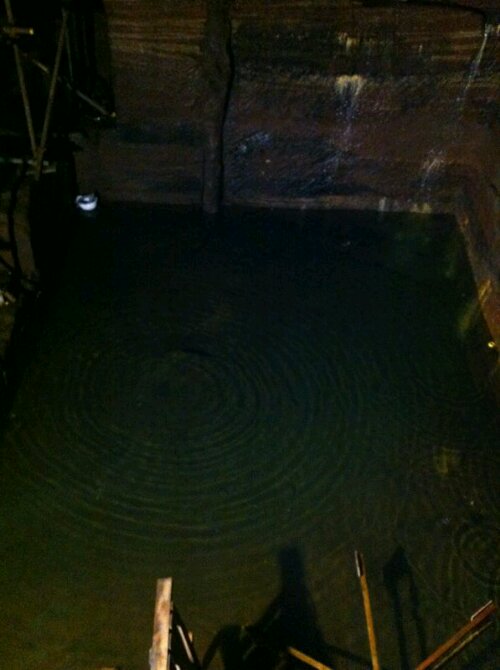
The next pic shows the left side of the pool with the scaffolding supporting the walkway we had to go on to get to the next section.
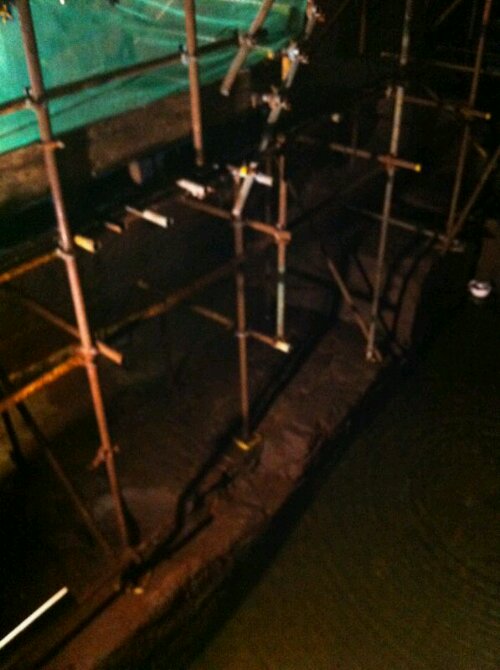
This next pic is of the area directly above the pool with the ripples in and you can just about see the high arch and the bricks forming it on the right.

Next is the walkway to the next section
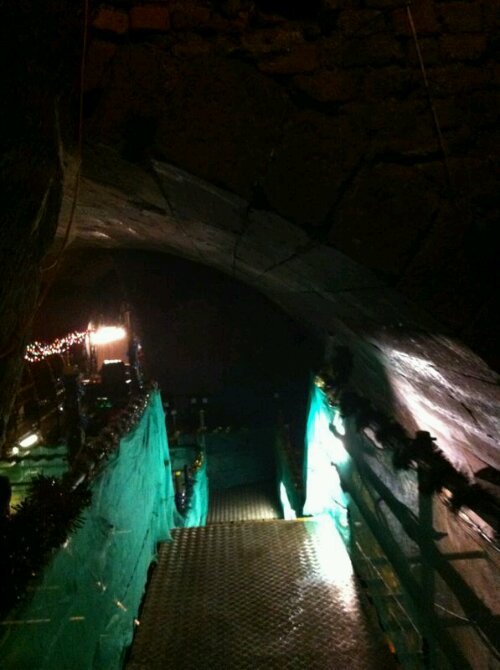
This walkway takes you through a narrow passage to the next tunnel where there are a few more displays.
This is a pic of some of the items recovered from tunnel excavations. Many had been used by the council to landfill with rubbish. The interesting thing in this one is the collection of shells at the far left on the lower shelf. They are oyster shells and the guide told me they were quite a common food for the workers because supply was a lot more plentiful in those days.
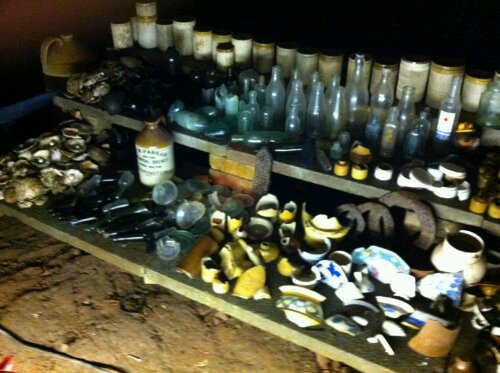
Next pic is of a double arch. The three small figures you can see, on the arch, are a Father Christmas, a snowman & a reindeer; these are part of the decorations for the kids who’ll be visiting between now and Christmas.
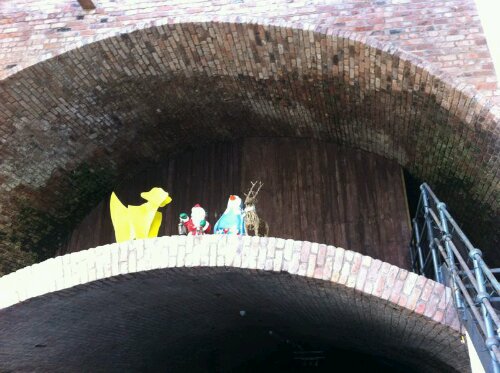
A little bit further round and I was shown another area of the tunnels which can only be viewed through a glass panel in the wall. Down the stairs back to ground level for a few closing comments and that was the end of the official tour. However as I’d been the only one on the tour I’d got to ask loads of questions so the whole thing was just really fascinating.
One story is that when Robert Stephenson (he of “The Rocket” fame) and his workforce were digging a tunnel down to what is now the railway terminus at Lime Street Station the floor of their tunnel gave way. Heads appeared through the floor and it was Williamson’s workers who were digging under the level of the men working for Stephenson.
So was he a philanthropist? Was he eccentric? Was he just keen on building “things” but especially houses and tunnels? Given the discovery of certain chapel –like features in the tunnels some believe he might have been preparing a place of safety from what he thought was a coming Armageddon. Was he? I suppose you could answer yes to all of those but we’ll never know for sure. As I left the centre, the lady on the till said the tunnels were actually warmer than the area on ground level!
Here's a pic of the cafe area from outside looking through the glass wall. If you look carefully you can see the double arch inside. The streaks down the glass are meant to be icicles just in case you were wondering.
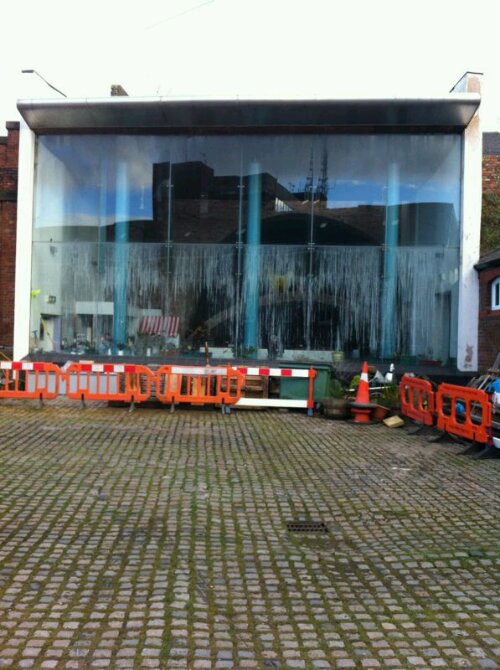
Finally here’s a view of the rest of the yard with a row of boarded up stables in the distance.
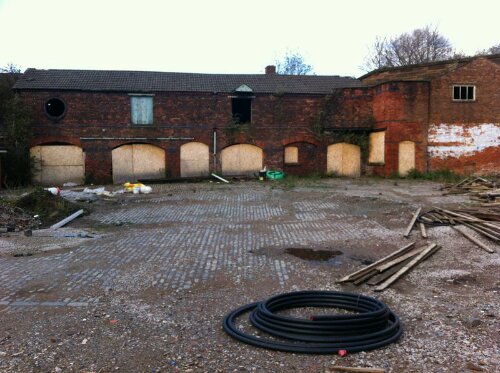
Before leaving I asked the guide where Mason Street was so I could look at the houses. He said they were all gone except one small bit. Here it is – it’s No.44 Mason St. As you can see it’s just the front wall of a house which has been preserved by putting a metal frame behind it to keep it upright; and this is all that remains of Williamson’s actual house. There had been another storey above but it had to be removed by the council to make the site safe. Entrance hatches to the tunnels lie behind this frontage but are not open to the public.
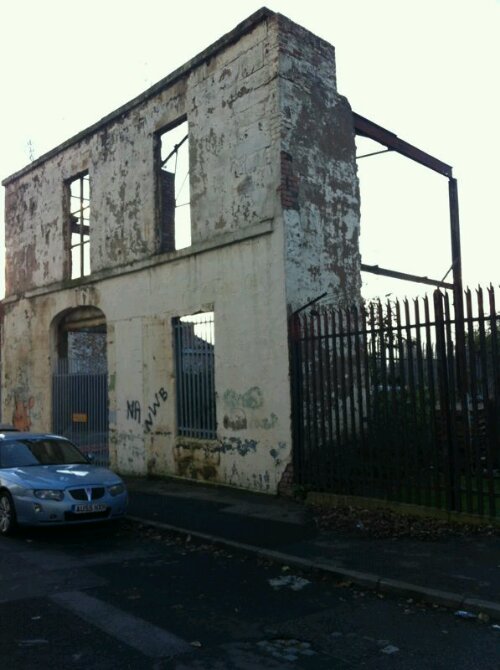
And that was it. Time for home and a nice hot cup of tea as it had been freezing outside as well as inside the tunnels.
I’d like to finish with a couple of rather contradictory quotes about the city of Liverpool:
1. In the mid 17th century Sir Edward Moore wrote that the men of Liverpool are, “….the most perfidious in all England, worse than my pen can describe”
2. In 1772 Dr Dobson, a physician to the Infirmary and whose work on diabetes was influential in bringing it under control said:
“The degrees of the soil, the purity of the waters, the mildness of the air, the antiseptic effluvia of pitch and tar, the acid exhalations from the sea, the pregnant brisk gales of wind and the daily visitations of the tides render Liverpool one of the healthiest places in the Kingdom.” Of course it is!
No comments:
Post a Comment